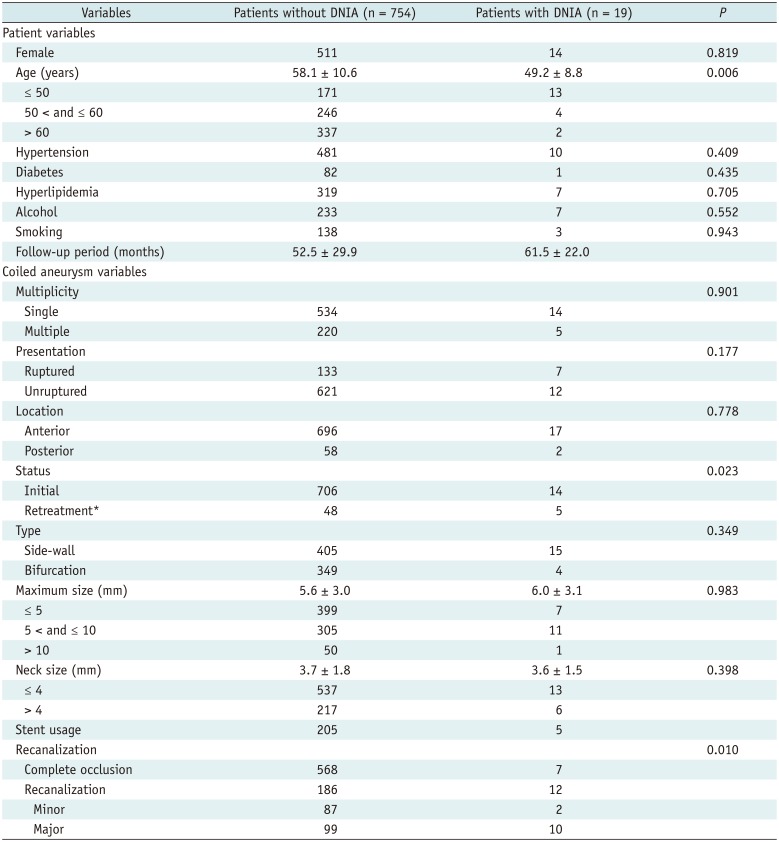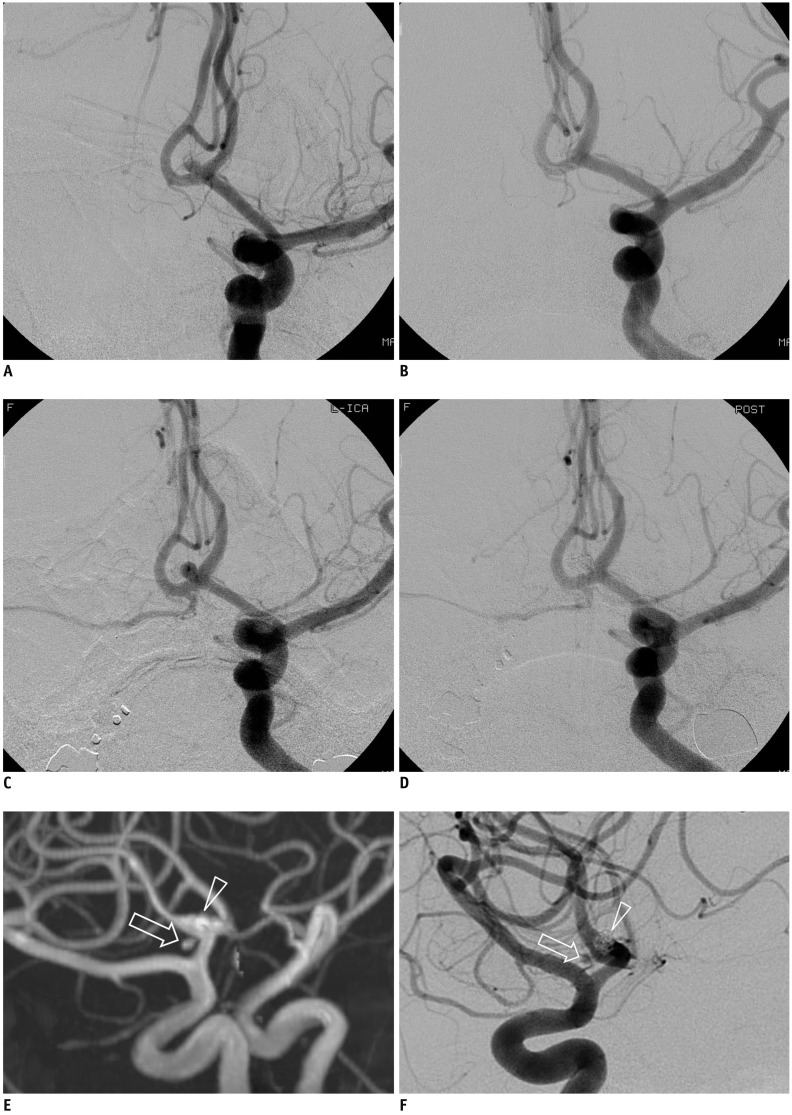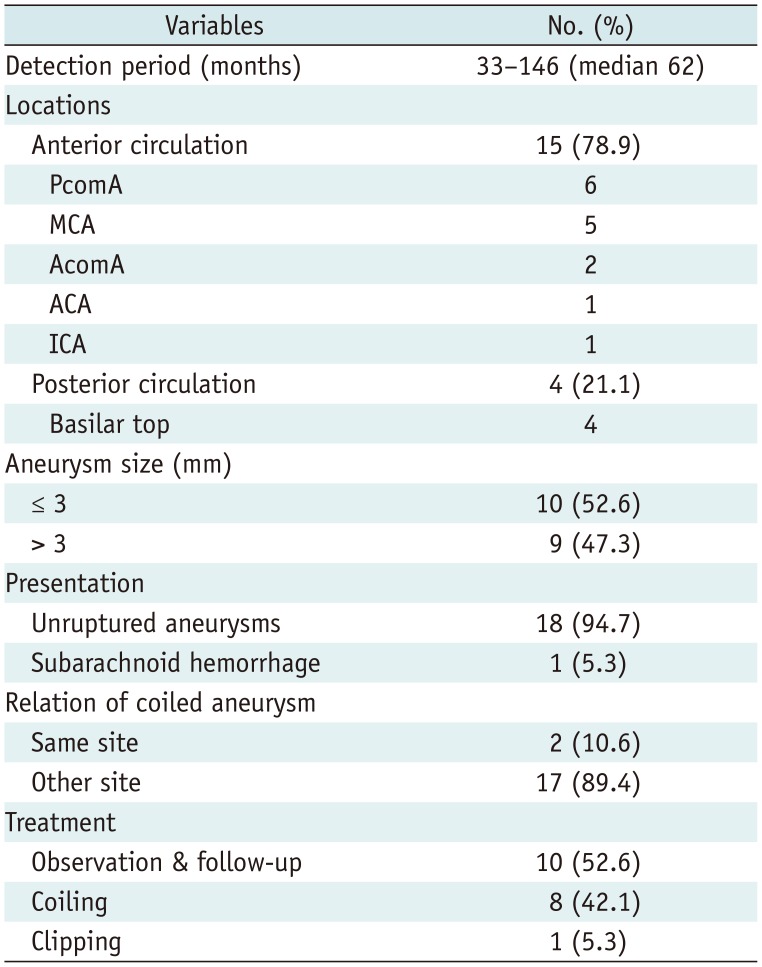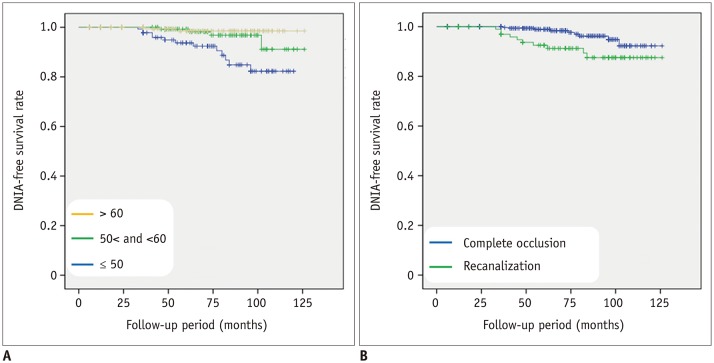1. Nieuwkamp DJ, Setz LE, Algra A, Linn FH, de Rooij NK, Rinkel GJ. Changes in case fatality of aneurysmal subarachnoid haemorrhage over time, according to age, sex, and region: a meta-analysis. Lancet Neurol. 2009; 8:635–642. PMID:
19501022.

2. Vlak MH, Algra A, Brandenburg R, Rinkel GJ. Prevalence of unruptured intracranial aneurysms, with emphasis on sex, age, comorbidity, country, and time period: a systematic review and meta-analysis. Lancet Neurol. 2011; 10:626–636. PMID:
21641282.

3. Giordan E, Lanzino G, Rangel-Castilla L, Murad MH, Brinjikji W. Risk of de novo aneurysm formation in patients with a prior diagnosis of ruptured or unruptured aneurysm: systematic review and meta-analysis. J Neurosurg. 2018; 131:1–11.

4. Ferns SP, Sprengers ME, van Rooij WJ, van den Berg R, Velthuis BK, de Kort GA, et al. De novo aneurysm formation and growth of untreated aneurysms: a 5-year MRA follow-up in a large cohort of patients with coiled aneurysms and review of the literature. Stroke. 2011; 42:313–318. PMID:
21164110.
5. Lindgren AE, Räisänen S, Björkman J, Tattari H, Huttunen J, Huttunen T, et al. De novo aneurysm formation in carriers of saccular intracranial aneurysm disease in Eastern Finland. Stroke. 2016; 47:1213–1218. PMID:
27026632.

6. Rahmah NN, Horiuchi T, Kusano Y, Sasaki T, Hongo K. De novo aneurysm: case reports and literature review. Neurosurgery. 2011; 69:E761–E766. discussion E766–E767. PMID:
21471840.

7. Zali A, Khoshnood RJ, Zarghi A. De novo aneurysms in long-term follow-up computed tomographic angiography of patients with clipped intracranial aneurysms. World Neurosurg. 2014; 82:722–725. PMID:
23827320.

8. Kheireddin AS, Filatov YM, Belousova OB, Eliava SS, Sazonov IA, Kaftanov AN, et al. [De novo cerebral aneurysms]. Zh Vopr Neirokhir Im N N Burdenko. 2015; 79:75–81.

9. Miller CA, Hill SA, Hunt WE. “De novo” aneurysms. A clinical review. Surg Neurol. 1985; 24:173–180. PMID:
4012574.

10. Sprengers ME, van Rooij WJ, Sluzewski M, Rinkel GJ, Velthuis BK, de Kort GA, et al. MR angiography follow-up 5 years after coiling: frequency of new aneurysms and enlargement of untreated aneurysms. AJNR Am J Neuroradiol. 2009; 30:303–307. PMID:
18971290.

11. Kemp WJ 3rd, Fulkerson DH, Payner TD, Leipzig TJ, Horner TG, Palmer EL, et al. Risk of hemorrhage from de novo cerebral aneurysms. J Neurosurg. 2013; 118:58–62. PMID:
23061385.

12. Wang JY, Smith R, Ye X, Yang W, Caplan JM, Radvany MG, et al. Serial imaging surveillance for patients with a history of intracranial aneurysm: risk of de novo aneurysm formation. Neurosurgery. 2015; 77:32–42. discussion 42–43. PMID:
25790068.
13. Serrone JC, Tackla RD, Gozal YM, Hanseman DJ, Gogela SL, Vuong SM, et al. Aneurysm growth and de novo aneurysms during aneurysm surveillance. J Neurosurg. 2016; 125:1374–1382. PMID:
26967775.

14. Juvela S, Poussa K, Porras M. Factors affecting formation and growth of intracranial aneurysms: a long-term follow-up study. Stroke. 2001; 32:485–491. PMID:
11157187.
15. Wermer MJ, van der Schaaf IC, Velthuis BK, Algra A, Buskens E, Rinkel GJ. ASTRA Study Group. Follow-up screening after subarachnoid haemorrhage: frequency and determinants of new aneurysms and enlargement of existing aneurysms. Brain. 2005; 128(Pt 10):2421–2429. PMID:
16000333.

16. van der Schaaf IC, Velthuis BK, Wermer MJ, Majoie C, Witkamp T, de Kort G, et al. ASTRA Study Group. New detected aneurysms on follow-up screening in patients with previously clipped intracranial aneurysms: comparison with DSA or CTA at the time of SAH. Stroke. 2005; 36:1753–1758. PMID:
16002762.
17. Burkhardt JK, Chua MHJ, Weiss M, Do ASS, Winkler EA, Lawton MT. Risk of aneurysm residual regrowth, recurrence, and de novo aneurysm formation after microsurgical clip occlusion based on follow-up with catheter angiography. World Neurosurg. 2017; 106:74–84. PMID:
28648910.

18. Bruneau M, Rynkowski M, Smida-Rynkowska K, Brotchi J, De Witte O, Lubicz B. Long-term follow-up survey reveals a high yield, up to 30% of patients presenting newly detected aneurysms more than 10 years after ruptured intracranial aneurysms clipping. Neurosurg Rev. 2011; 34:485–496. PMID:
21643681.
19. Cho YD, Kim KM, Lee WJ, Sohn CH, Kang HS, Kim JE, et al. Time-of-flight magnetic resonance angiography for follow-up of coil embolization with enterprise stent for intracranial aneurysm: usefulness of source images. Korean J Radiol. 2014; 15:161–168. PMID:
24497808.

20. Roy D, Milot G, Raymond J. Endovascular treatment of unruptured aneurysms. Stroke. 2001; 32:1998–2004. PMID:
11546888.

21. TakahashiS. Neurovascular imaging: MRI & microangiography. London: Springer-Verlag;2010. p. 345–372.
22. Jabbarli R, Dinger TF, Darkwah Oppong M, Pierscianek D, Dammann P, Wrede KH, et al. Risk factors for and clinical consequences of multiple intracranial aneurysms: a systematic review and meta-analysis. Stroke. 2018; 49:848–855. PMID:
29511128.
23. David CA, Vishteh AG, Spetzler RF, Lemole M, Lawton MT, Partovi S. Late angiographic follow-up review of surgically treated aneurysms. J Neurosurg. 1999; 91:396–401. PMID:
10470813.

24. Kim ST, Jeong HW, Jeong YG, In HS. Coiling as retreatment in intracranial aneurysm of de novo formation or regrowth: case report. Neurointervention. 2013; 8:46–51. PMID:
23515648.
25. Brown MA, Parish J, Guandique CF, Payner TD, Horner T, Leipzig T, et al. A long-term study of durability and risk factors for aneurysm recurrence after microsurgical clip ligation. J Neurosurg. 2017; 126:819–824. PMID:
27128583.

26. Bor AS, Rinkel GJ, van Norden J, Wermer MJ. Long-term, serial screening for intracranial aneurysms in individuals with a family history of aneurysmal subarachnoid haemorrhage: a cohort study. Lancet Neurol. 2014; 13:385–392. PMID:
24618352.

27. Miyazawa N, Akiyama I, Yamagata Z. Risk factors for growth of unruptured intracranial aneurysms: follow-up study by serial 0.5-T magnetic resonance angiography. Neurosurgery. 2006; 58:1047–1053. PMID:
16723883.

28. Juvela S, Poussa K, Lehto H, Porras M. Natural history of unruptured intracranial aneurysms: a long-term follow-up study. Stroke. 2013; 44:2414–2421. PMID:
23868274.

29. Lai LT, Morgan MK, Patel NJ. Smoking increases the risk of de novo intracranial aneurysms. World Neurosurg. 2014; 82:e195–e201. PMID:
24518886.

30. Phan TG, Huston J 3rd, Brown RD Jr, Wiebers DO, Piepgras DG. Intracranial saccular aneurysm enlargement determined using serial magnetic resonance angiography. J Neurosurg. 2002; 97:1023–1028. PMID:
12450022.

31. Goksu E, Korkmaz E, Akyuz M, Ozgur O, Sindel T, Tuncer R. The analysis of long-term follow-up screening in patients with surgically treated intracranial aneurysms. Turk Neurosurg. 2015; 25:404–409. PMID:
26037180.
32. Akyüz M, Tuncer R, Yilmaz S, Sindel T. Angiographic follow-up after surgical treatment of intracranial aneurysms. Acta Neurochir (Wien). 2004; 146:245–250. discussion 250. PMID:
15015046.
33. Lecler A, Raymond J, Rodriguez-Régent C, Al Shareef F, Trystram D, Godon-Hardy S, et al. Intracranial aneurysms: recurrences more than 10 years after endovascular treatment-a prospective cohort study, systematic review, and meta-analysis. Radiology. 2015; 277:173–180. PMID:
26057784.

34. Cho YD, Jeon JP, Yoo DH, Cho WS, Kang HS, Kim JE, et al. Growth-related major recanalization of coiled aneurysms: incidence and risk factors. Neurosurgery. 2018; 82:185–191. PMID:
28605492.

35. Abdihalim M, Watanabe M, Chaudhry SA, Jagadeesan B, Suri MF, Qureshi AI. Are coil compaction and aneurysmal growth two distinct etiologies leading to recurrence following endovascular treatment of intracranial aneurysm? J Neuroimaging. 2014; 24:171–175. PMID:
23317437.

36. Xu L, Sugawara M, Tanaka G, Ohta M, Liu H, Yamaguchi R. Effect of elasticity on wall shear stress inside cerebral aneurysm at anterior cerebral artery. Technol Health Care. 2016; 24:349–357. PMID:
26835728.

37. Lee CJ, Zhang Y, Takao H, Murayama Y, Qian Y. A fluid-structure interaction study using patient-specific ruptured and unruptured aneurysm: the effect of aneurysm morphology, hypertension and elasticity. J Biomech. 2013; 46:2402–2410. PMID:
23962529.

38. Jahed M, Ghalichi F, Farhoudi M. Fluid-structure interaction of patient-specific Circle of Willis with aneurysm: investigation of hemodynamic parameters. Biomed Mater Eng. 2018; 29:357–368. PMID:
29578465.

39. Molyneux AJ, Kerr RS, Birks J, Ramzi N, Yarnold J, Sneade M, et al. ISAT Collaborators. Risk of recurrent subarachnoid haemorrhage, death, or dependence and standardised mortality ratios after clipping or coiling of an intracranial aneurysm in the International Subarachnoid Aneurysm Trial (ISAT): long-term follow-up. Lancet Neurol. 2009; 8:427–443. PMID:
19329361.









 PDF
PDF ePub
ePub Citation
Citation Print
Print




 XML Download
XML Download